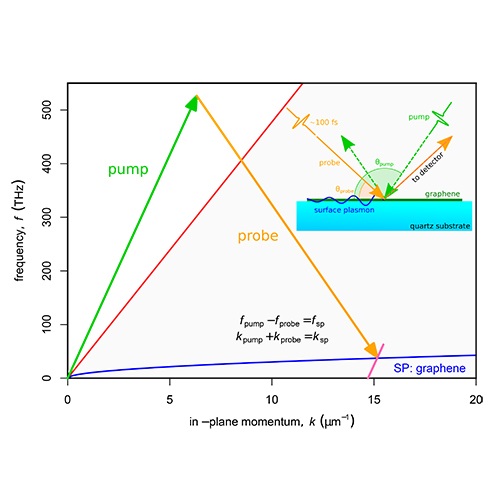2015/11/19
Surface plasmons in graphene offer a compelling platform for photonic technologies, exhibiting intriguing properties such as electro-optical tunability, a very small wavelength, and high electromagnetic field concentration. Graphene plasmons also exhibit a large bandwidth, extending into the far infrared. Some of these properties simultaneously make graphene plasmons difficult to excite and detect, due to the large mismatch between the wavelengths of free-space and plasmon fields, and the need for sources and detectors at unconventional frequencies.
An experimental research team led by Prof. Euan Hendry at Exeter University, in collaboration with the theory group of Prof. Darrick Chang at ICFO, has demonstrated an appealing alternative to exciting and detecting graphene plasmons, which was recently published in Nature Physics. In this work, the team demonstrates that graphene exhibits a giant nonlinear optical response, which can be used to convert free-space optical beams to plasmons of a well-defined frequency and direction via a coherent mixing process. The excitation of plasmons is inferred by a change in reflection of the input fields. Interestingly, all of the optical sources and detectors used in the experiment operated at visible wavelengths, yet it was possible to generate plasmons at frequencies down to the far infrared. The potential to excite and detect plasmons only with free-space optics, and at frequencies significantly different than that of the plasmons themselves, has the potential to significantly expand the technological possibilities for graphene plasmonics.
In this proof of principle experiment, conversion efficiencies of 10-5 were achieved between photons in the free-space beams and plasmons. It is anticipated that moderate improvements to the devices and setup can enable improvements in efficiencies by several orders of magnitude. Interestingly, in the current experiments, it could also be inferred that the second-order nonlinear coefficients of graphene are about 1000 times larger than in conventional nonlinear crystals. This suggests that graphene more generally constitutes a novel material for future nonlinear optical devices.
Link to the paper
Link to the research group led by Darrick Chang

Nonlinear excitation of graphene plasmons
The nonlinear response of graphene enables excitation and detection of plasmons using far-field optics

Nonlinear excitation of graphene plasmons













